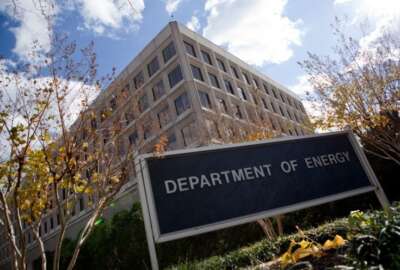
The Energy Department moves to bolster production of strategic minerals from US soil, Pt. 2
How the federal government can bolster domestic production of rare-earth elements crucial to electric vehicles and other energy imperatives.
Best listening experience is on Chrome, Firefox or Safari. Subscribe to Federal Drive’s daily audio interviews on Apple Podcasts or PodcastOne.
We continue our discussion of how the federal government can bolster domestic production of rare-earth elements crucial to electric vehicles and other energy imperatives. For more on the elements themselves and why they matter, Federal Drive with Tom Temin spoke with acting director and research and development consortia program manager from the Department of Energy’s Advanced Manufacturing office, Dr. Mike McKittrick. (Click here for part one)
Interview transcript:
Tom Temin: Mike, good to have you on.
Dr. Mike McKittrick: Thanks for having me.
Tom Temin: Let’s talk about some of these rare earths and other types of materials. Everyone knows about cobalt, because that’s been an issue for magnets for 40 or 50 years. And lithium, we know about that in batteries. But there’s a whole range of these materials and elements, aren’t there? Give us a sense of them.
Dr. Mike McKittrick: There are. So in the United States doesn’t have any domestic production, it relies completely on imports for a number of materials, including rare earth elements, which are probably one of the other good examples. While we have the raw material resources for rare earth elements, we lacked the downstream processing and manufacturing capabilities to make things like high strength magnets from neodymium, which is one of the rare earth elements. And we need these strong magnets for things like electric vehicle motors or wind generators.
Tom Temin: Okay. And there’s 35 of them that have been identified, I guess, by the Energy Department or by some authority that says these really count.
Dr. Mike McKittrick: Several years ago, the Department of Energy worked with our interagency colleagues, including the Department of Interior, to identify a list of 35 critical minerals that had some supply chain challenges.
Tom Temin: And are we talking basically about those types of materials that would be needed in electric power generation, electric cars, windmills — that is non-fossil fuel generation, non-nuclear?
Dr. Mike McKittrick: The list of that the Department of Energy built with the Department of Interior several years ago was looking at the economy wide materials. But at the Department of Energy, we are particularly interested in those critical materials that allow us to produce and manufacture and deploy those clean energy technologies here in the US. So things like electric vehicles, lithium ion batteries or wind generators.
Tom Temin: Okay. And what is the issue because the grant program implies that we can mine and refine or whatever you call it, I guess it varies according to the material, these things from US soil. So how come we don’t already?
Dr. Mike McKittrick: Issue isn’t just about having the raw materials. And as we can mine the materials there needs to be separation, processing and manufacturing to incorporate these materials into products like electric vehicle motors, wind generators, or lithium ion batteries for storage. But the key challenges that the US lacks the downstream processing manufacturing capability for critical materials like medium for rare earth magnets. And that ultimately results in US exporting domestically produced ores for further processing.
Tom Temin: So we can dig it up. But that’s about all we can do is make a big truckload of dirt. And something important is in that, but we can’t get it out.
Dr. Mike McKittrick: That’s right. And we would like to be able to do that value add processing and manufacturing, which will enable us manufacturers to produce things like electric vehicles, wind generators, and allow us to deploy more of those technologies and like in the United States.
Tom Temin: So the idea is to not be dependent on foreign sources for the processing and the finished material.
Dr. Mike McKittrick: Absolutely.
Tom Temin: Okay. And where are these things located? Are they in the southwest? Are they all over the country? Do we know where they are?
Dr. Mike McKittrick: Working with our colleagues at the Department of Interior, like the United States Geological Survey, as well as some of the other work going on in the Department of Energy, we have a good sense of where some of the geological resources are. And for many of the critical materials, the US has the geological resources we need. Globally, rare earth elements we get about 80% of our imports sourced from China, for cobalt, which is needed for lithium ion batteries. raw materials are largely sourced from the Democratic Republic of Congo.
Tom Temin: Got it. And what do they know that we don’t know with respect to this processing and downstream value add? Because it’s been done for a long time? Is this simply something that has atrophied this capability in the United States or, I mean, you’re offering research grants. So it sounds like there’s some learnings that we could do and maybe leapfrog those countries — or you tell me.
Dr. Mike McKittrick: What the Department of Energy is looking to do with our research and development is developing technologies that allow for innovation across the supply chain for these materials, and especially on the separation and processing and manufacturing side, we want to reduce the environmental impacts of that production, reduce costs, and allow us manufacturers to be globally competitive in that market.
Tom Temin: And the environmental question, I guess is an important one because even if you know how to mined something and refine it, we probably have different standards maybe than the Congo or than China. So do you envision some of the research going toward that end of things to do this refining and value add in an environmentally favorable way?
Dr. Mike McKittrick: Absolutely. A lot of the research and development doing in the advanced manufacturing office with a program we call the critical materials Institute is looking at how to again use a more environmentally friendly processing techniques. Reducing solvents and harmful chemicals, as well as improving reuse and recycling. That’s another key aspect of the environmental side here. And we can also by being more efficiently using materials that exist in products like lithium ion batteries, or hard disk drives, we can reduce the environmental impact of the critical material supply chain, how to recover and reuse rare earth domains from hard disk drives.
Tom Temin: We’ve also worked with entrepreneurs to develop solutions to collect store and essentially reuse lithium ion batteries. Got it? I guess that recycling question, probably one of the questions you’ll be looking at research for possibly is how to do it in a way that the value of the material you get out of it exceeds what it costs to recycle it in the first place?
Dr. Mike McKittrick: Yes, absolutely. That’s one of the things we’re looking at is we recycle a hard disk drive looking at the neodymium rare earth magnet that’s included in there? How can we use innovative manufacturing technologies like 3D printing to recover the reverse and actually make new magnets that we can reuse?
Tom Temin: Because if you can buy a two or four terabyte drive for 100 bucks, you don’t want to spend $1,000 getting the lithium out of it when you’re done with it or whenever the material is? Exactly. Okay. And what about this possibility of substitutes is some of the research aimed at those and we keep saying lithium ion batteries, maybe there’s, you know, kryptonite ion batteries or something that we could develop. And we’ve got lots of it right here.
Dr. Mike McKittrick: Developing substitutes is a key part of the department of energy strategy, along with improving supply chains and improving reuse and recycling. For substitutes, we’re looking at material or even system substitutes that can allow us to find replacements for rare earth elements or lithium or cobalt. Again, with within the advanced manufacturing office. We’re looking at new materials or manufacturing methods like additive manufacturing, or 3d printing to replace rare earth magnets in partnership with the vehicle technology office in the Office of Energy efficiency, renewable energy. We’re also looking at how to reduce the US dependence on cobalt and lithium, which we need for lithium ion batteries. So that’s through both the manufacturing process and recycling. How do we reduce the cobalt needed for these batteries? or potentially eliminating the need for cobalt altogether? While we’re meeting the performance and requirements for electric vehicles?
Tom Temin: Yeah, so this is really a whole complex of issues you’re looking at from the ground to say, a 3d printer, then it sounds like it’s going to be a range of types of research grants that you envision here.
Dr. Mike McKittrick: Yes. And the Department of Energy has been funding research in this area for many years. And we’re building off of that with the Office of Science announcement that recently came out.
Tom Temin: But there’s a new urgency to it isn’t there with national policy changing and the drive for these new technologies really increasing in demand quite a bit?
Dr. Mike McKittrick: Absolutely. These issues have been, especially rare elements, have been well known for about a decade. But it’s important as we’re thinking about the deployment and manufacturing of clean energy technologies like electric vehicles, wind generators, here in the US.
Copyright © 2024 Federal News Network. All rights reserved. This website is not intended for users located within the European Economic Area.
Tom Temin is host of the Federal Drive and has been providing insight on federal technology and management issues for more than 30 years.
Follow @tteminWFED
Related Stories

This Energy Department program says cars will run more efficiently without the person behind the wheel




